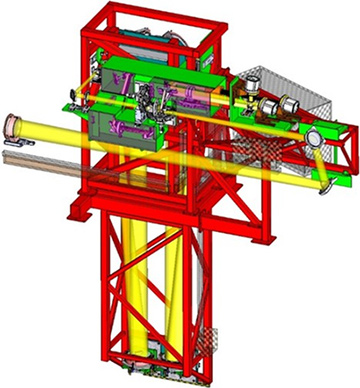 The VTF optomechanical layout depicts the light path in yellow, starting from the main imaging lens; the mechanical support structure in red; and other optomechanical components in different colors. The locations of the large etalons are highlighted, as well as those of the focal-plane detectors. [Leibniz Institute for Solar Physics (KIS)]
The VTF optomechanical layout depicts the light path in yellow, starting from the main imaging lens; the mechanical support structure in red; and other optomechanical components in different colors. The locations of the large etalons are highlighted, as well as those of the focal-plane detectors. [Leibniz Institute for Solar Physics (KIS)]
Inside DKIST’s Visible Tunable Filter
What does a sun-gazing instrument have in common with a detector for gravitational waves? Both require incredible optical precision.
The Visible Tunable Filter (VTF), designed for the Daniel K. Inouye Solar Telescope (DKIST), may have an anodyne name, but it has a challenging scientific goal: to provide narrow-band, diffraction-limited imaging spectroscopy and spectropolarimetry of short-lived features in the sun’s chromosphere and photosphere.
According to DKIST director Thomas Rimmele, VTF is an “optically very challenging instrument” that contains two large, extremely high-precision Fabry-Pérot etalons. Unlike their counterparts in gravitational-wave detectors, which sit several kilometers apart, the VTF etalons have only a tiny gap between them.
In fact, with an aperture of 250 mm, the VTF etalons are the biggest ever made, says Oskar von der Lühe, deputy director of the Leibniz Institute for Solar Physics in Freiburg, Germany, and the lead scientist for VTF. The actual fused-silica plates are 350 mm in diameter and 100 mm thick, with a mass of 20 kg each. (Commercially available Fabry-Pérot etalons are typically 1 mm to 100 mm wide.)
But the required precision of the air-spaced etalons is “more or less unheard of,” von der Lühe says. The variation of the gaps is less than 400 pm rms over areas of “micro-roughness,” or patches less than 1 mm across. Large-scale figure errors across 1 mm or more of the surface are less than 300 pm rms. The separation between the etalons can be controlled with a precision of 150 pm, and the scanning range for tuning the wavelength of the passband is 1.2 µm.
The VTF will have a spectral range of 520 nm to 870 nm, a full width at half maximum (FWHM) of 6 pm to 8 pm (specifically, 6 pm at a 600-nm wavelength) and a field of view of 60 arcseconds. At the distance from Earth to the sun, the instrument can image a swath 42,000 km wide and resolve features on the scale of a few tens of kilometers.
Once it arrives at the DKIST site at Haleakala Observatory, Hawaii, USA, later in 2021, engineers will install the VTF on the rotating Coudé platform (diameter: 16.5 m) that holds the telescope’s instruments and the optical components—dichroic beam splitters, mirrors and windows—that distribute the incoming light beam among the instruments. In many cases, observers will have the ability to switch among available instruments to respond to short-timescale changes in solar weather.
Von der Lühe’s laboratory is better known by its previous name, the Kiepenheuer Institute for Solar Physics, or KIS. DKIST officials selected Leibniz/KIS to build VTF a decade ago due to its experience in building a similar instrument for a smaller solar observatory in Tenerife, Spain.
Development and testing of the VTF “have been pretty much a roller-coaster ride,” with technical hurdles that the team didn’t anticipate, says von der Lühe. He adds that he will be grateful when its installation on Haleakala is complete and observers can use it for science.
New Eyes on the Sun: References and Resources
O. von der Lühe. “History of solar telescopes,” Exp. Astron. 25, 193 (2009).
A. Tritschler et al. “Daniel K. Inouye Solar Telescope: High-resolution observing of the dynamic sun,” Astron. Nachr. 337, 1064 (2016).
D. Schmidt et al. “Clear widens the field for observations of the sun with multi-conjugate adaptive optics,” Astron. Astrophys. 597, L8 (2017).
D. Schmidt et al. “The concept of the MCAO upgrade for the Daniel K. Inouye Solar Telescope,” proceedings of the Adaptive Optics for Extremely Large Telescopes (AO4ELT6) conference (Quebec, Canada, June 2019).
P. Hess et al. “WISPR imaging of a pristine CME,” Astrophys. J. Supp. Ser. 246, 25 (2020).
R. Howard et al. “The Solar Orbiter Heliospheric Imager (SoloHI),” Astron. Astrophys. 642, A13 (2020).
C. Rao et al. “First light of the 1.8-m solar telescope—CLST,” Sci. China Phys. Mech. 63, 109631 (2020).
P. Rochus et al. “The Solar Orbiter EUI Instrument: The Extreme Ultraviolet Imager,” Astron. Astrophys. 642, A8 (2020).
A. Szabo et al. “The heliospheric current sheet in the inner heliosphere observed by the Parker Solar Probe,” Astrophys. J. Supp. Ser. 246, 47 (2020).
-
W. Schmidt et al. “End-to-end simulations of the Visible Tunable Filter for the Daniel K. Inouye Solar Telescope,” Proc. SPIE 9908, 99084N (2016).
-
T.R. Rimmele et al. “The Daniel K. Inouye Solar Telescope—observatory overview,” Sol. Phys. 295, 172 (2020).
